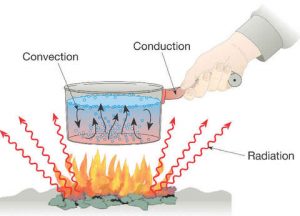

Our mission – making a better barbecue pit – is an engineering challenge. So why not jump in with some basic barbecue thermodynamics?
Heat flows from hot to cold by three modes:
Whether you’re broiling, baking, or frying, 99% of your meat’s volume – all but the outer surface – is being cooked by conduction from the outside inwards. The heat transfer mode only determines how the heat gets to the meat’s surface. As we’ll learn in How Meat Cooks, we’re raising the meat’s internal temperature way past “well-done” to break down the tough connective tissues into silky, flavorful gelatin. This denaturing takes time, and we have to do it without overheating any part of the meat. That requires low temperatures and no hot spots – impossible when frying and difficult when broiling without rotisseries, etc. So we use convection – we bake the meat – which also imparts aromatic flavors from the fire.
A barbecue pit is just a wood-fired oven.